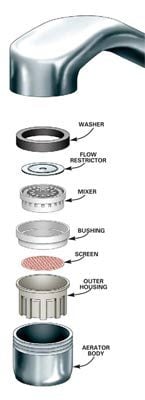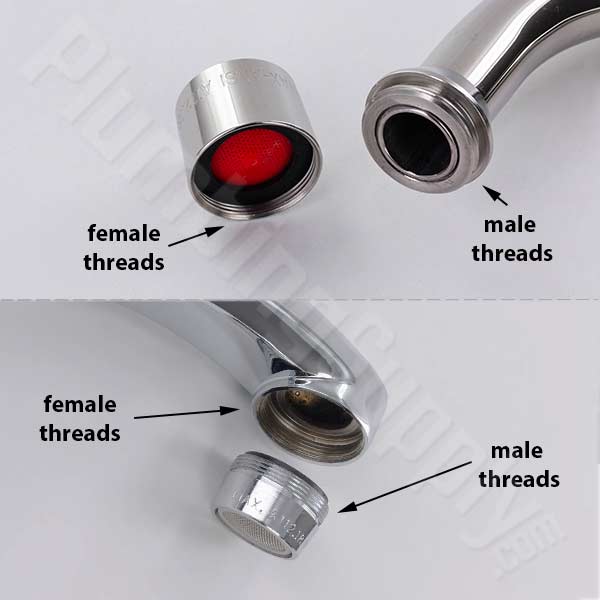Clean water is sent to your home under constant pressure to ensure it makes its way throughout the community ending at your tap which normally contains a faucet aerator that performs a few different important functions that you never realized. What does a faucet aerator do?
Aerators:
- Add air to H2O for the feeling of high-pressure
- Control the stream from the faucet
- Act as a filter to catch sand & debris that accumulates in H2O lines
- Prevent splashing
- Shape the H2O stream coming out of the faucet
- Prevents noise
- Conserve the amount of overall H2O usage
- Reduce energy consumption
A Faucet aerator is normally a simple, mesh screen made of metal or plastic that is attached to the end of a faucet with some sort of housing. As water flows through this screen it is divided into many small streams with air in between. This little guy has a big job lowering water consumption, and utility bills and over the long term saving the environment.
What is a Faucet Aerator
A faucet aerator is a small, often cylindrical device attached to the tip of indoor water faucets. Its primary function is to mix air into the water stream, which helps reduce water usage while maintaining the feeling of a high-pressure flow.
By breaking the water into finer droplets, an aerator creates a more consistent and splash-free stream, enhancing the efficiency and comfort of water use in kitchens and bathrooms. Aerators typically consist of a mesh screen that divides the flow of water into multiple small streams, adding air and thus reducing the volume of water coming out without decreasing pressure. This not only conserves water but also aids in reducing energy costs, as less hot water is required.
Faucet aerators come in various sizes and flow rates, allowing users to choose one that best suits their needs. For instance, aerators with lower flow rates are ideal for sinks where conservation is a priority, while higher flow rates might be preferred in scenarios requiring faster filling of containers. Installation and maintenance of aerators are straightforward, often requiring minimal tools, making them a practical solution for households aiming to enhance water efficiency. They also serve as a simple yet effective measure to reduce water bills and support environmental sustainability.
Moreover, aerators can help in filtering out debris and contaminants, improving the overall quality of the water. They can also be customized to fit different types of faucets and to achieve desired water pressures and spray patterns. Over time, however, aerators can become clogged with mineral deposits, necessitating periodic cleaning or replacement to maintain optimal performance. Despite this, their benefits in terms of water conservation, cost savings, and user comfort make them a valuable addition to any home plumbing system.
In essence, a faucet aerator is a small but mighty component that significantly contributes to efficient water usage. Its ability to deliver a steady, aerated stream of water while conserving resources highlights its importance in modern water management practices. For environmentally-conscious individuals and those looking to reduce household expenses, installing faucet aerators is a simple and impactful step toward achieving these goals.
Faucet aerators are screens that screw into the kitchen and bathroom faucets that contain holes in the screens which add air to the water as it streams out of the faucet. Besides adding air to the water and leaving the faucet their job more importantly these aerators:
- Reduce the amount of water that comes out of a faucet and control the stream.
- They can catch particles that can make it through your supplier’s service lines. A faucet aerator screen can act as a filter and catch sand and debris that is produced over time or after your water supplier performs hydrant flushing during the year.
- Prevent splashing
- Shape the water stream coming out of the faucet spout, to produce a straight and evenly pressured stream regulating the flow
- Prevent noise
- Saving water then equates to energy cost reduction
The Environmental Protection Agency (EPA) has developed a program that identifies a water-efficient product that has been independently certified to meet EPA WaterSense criteria for efficiency and performance.
The EPA says that certain recommended faucets and aerators can meet their criteria to reduce the water demand. A little job like switching from an aerator that releases 2.2 gallons per minute to one that releases 1.5 gallons per minute can reduce water use by 30% without reducing performance. 
The organization will certifiy the product identified by the label if it meets the criteria. These products include faucets and faucet aerators that can meet these specifications that the government agency determines will cut costs of water consumption over periods of time, reduceing the demands on households. Achieving these savings can be as easy as twisting on a WaterSense labeled aerator, which can cost as little as a few dollars. When buying one look for this label!
How to Remove Faucet Aerator

Some Delta faucets come with recessed aerators, which are hidden and can’t be removed using a wrench. If you don’t have the specific Delta key, you might be able to get a universal key from a hardware store or get a good bite using your fingers it’s most likely it’s only hand tight anyway. If that is not possible use a pair of needle-nose pliers to remove the hidden piece.
Moen faucet aerators have ridges built into them so you can turn them. If you can’t unscrew the piece with your fingers, you might be able to get a better grip with your fingernails or use a butter knife or flathead screwdriver. To remove-Turn the aerator counterclockwise.
On a standard Aerator, try to turn by hand- if it won’t budge then use pliers to turn the outside of the housing protecting the piece with a washcloth. (the rubber washer will normally stick up in the faucet’s opening so you may have to dig it out) Some aerators have male threads others have female threads.
- If your faucet has threads on the outside, it is male threaded – which means you need to buy a FEMALE threaded aerator to fit over it.

- If your faucet has threads on the inside, it is female threaded and you’ll need a MALE threaded aerator
Look for the EPA Water Sense logo or seal on the packaging these products offer equivalent or superior performance while helping you protect the environment and potentially save on utility bills. Look for the WaterSense label on our water-efficient products.
Many aerators aren’t very difficult to remove and are normally hand-tightened. Recessed models can be a little more tricky than exterior models because there’s no way to remove them with a wrench or pliers.
If you can’t make it budge then use a hairdryer just run the hot air on the tip of the faucet aerator to warm it up-then turn it counterclockwise. When all else fails call a plumber if you can’t remove it but there is no reason to think you can’t it’s a simple chore.
Cleaning Faucet Aerator
Water pressure has decreased in your faucet, the aerator may be the problem. An aerator can get clogged with silt and debris or the buildup of minerals from the water. No problem it’s a quick and easy fix. To clean the aerator, simply unscrew and remove the mesh. It might just need rinsing and scrubbing off with a small brush, like an old toothbrush. Mineral buildup can be removed by soaking the aerator in a 50/50 solution of water and vinegar for several hours or using a mild descaler, such as Lime-Away.
Once you decide to take off the faucet aerator to clean it:
Cleaning a faucet aerator is a straightforward process that can help maintain water flow and quality. Here are the steps to clean a faucet aerator:
- Gather Supplies:
- Adjustable wrench or pliers
- An old toothbrush or small brush
- Bowl or cup
- White vinegar or a descaling solution
- Soft cloth or paper towel
- Turn Off the Faucet:
- Ensure the water is off before starting to prevent any spills or splashes.
- Remove the Aerator:
- Use an adjustable wrench or pliers to unscrew the aerator from the faucet gently. Protect the aerator with a cloth to avoid scratching if using pliers.
- Disassemble the Aerator:
- Carefully remove the aerator components: the screen, rubber washer, and housing.
- Soak the Parts:
- Place the disassembled parts in a bowl or cup filled with white vinegar. Let them soak for about 30 minutes to loosen mineral deposits.
- Scrub the Parts:
- Use an old toothbrush or small brush to scrub away any remaining debris and mineral buildup. Pay special attention to the mesh screen and the inner parts.
- Rinse Thoroughly:
- Rinse all the parts under running water to wash away the vinegar and loosened deposits.
- Check for Remaining Debris:
- Inspect the parts for any remaining buildup. If necessary, repeat the soaking and scrubbing process.
- Reassemble the Aerator:
- Once clean, reassemble the aerator parts in the correct order.
- Reattach the Aerator:
- Screw the aerator back onto the faucet. Ensure it is tightened securely, but do not over-tighten, as this could damage the threads.
- Turn On the Faucet:
- Turn the faucet back on and check for leaks. Ensure the water flow is steady and unobstructed.
- Repeat Regularly:
- To maintain optimal performance, clean the aerator every few months or as needed, especially if you notice reduced water flow.
By following these steps, you can ensure your faucet aerator remains clean and functional, helping to maintain water pressure and quality in your home.
Conclusion:
Faucet aerators are small yet essential devices that significantly enhance the efficiency and functionality of household faucets. By mixing air with water, they reduce water consumption without compromising the user experience, making them a simple and cost-effective solution for conserving water and energy.
Regular cleaning and maintenance of aerators ensure they function optimally, providing a consistent and splash-free water flow. Installing or replacing an aerator is an easy DIY task that requires minimal tools, making it accessible for most homeowners.
These devices come in various sizes and types, allowing customization to suit specific needs and preferences. Using faucet aerators not only benefits individual households by lowering water and energy bills but also contributes to broader environmental conservation efforts. Their ability to filter out debris and improve water quality adds an extra layer of utility.
Despite occasional maintenance requirements, the advantages of faucet aerators far outweigh the minimal effort needed to keep them in good condition. Overall, incorporating faucet aerators into home plumbing systems is a smart and sustainable choice. By doing so, homeowners can enjoy efficient water use, reduced costs, and a positive impact on the environment.

References: EPA Bathroom Faucets
Tap-The Big Benefit of Updating Faucets
FAQ’s
- How do I know if my faucet has an aerator? Most modern faucets come with aerators pre-installed. You can identify an aerator by looking at the tip of the faucet; it usually has a mesh screen or a small cap that can be unscrewed.
- How often should I clean my faucet aerator? It’s recommended to clean your faucet aerator every few months, or more frequently if you notice a decrease in water flow or if you live in an area with hard water, which can cause mineral buildup.
- What tools do I need to clean a faucet aerator? To clean a faucet aerator, you typically need an adjustable wrench or pliers, an old toothbrush or small brush, a bowl, white vinegar, and a soft cloth or paper towel.
- How do I remove a faucet aerator? Use an adjustable wrench or pliers to unscrew the aerator from the faucet gently. Protect the aerator with a cloth if using pliers to avoid scratching it.
- What should I do if my aerator is clogged? If your aerator is clogged, soak it in white vinegar for about 30 minutes to loosen mineral deposits. Then, scrub it with an old toothbrush or small brush and rinse it thoroughly before reassembling and reattaching it to the faucet.
- Can I replace my faucet aerator with a different one? Yes, you can replace your faucet aerator with one that has a different flow rate or spray pattern. Make sure to choose the right size and type for your faucet.
- Are faucet aerators universal? Faucet aerators come in different sizes and thread types (male or female). It’s important to check the specifications of your faucet and the aerator to ensure compatibility.
- Do faucet aerators reduce water pressure? Faucet aerators reduce the volume of water flow but do not typically reduce water pressure. Instead, they mix air into the water stream to maintain the sensation of a high-pressure flow.
- How do faucet aerators help conserve water? Faucet aerators mix air with the water, reducing the total volume of water used without compromising the flow. This helps to lower water consumption and reduce water bills.

